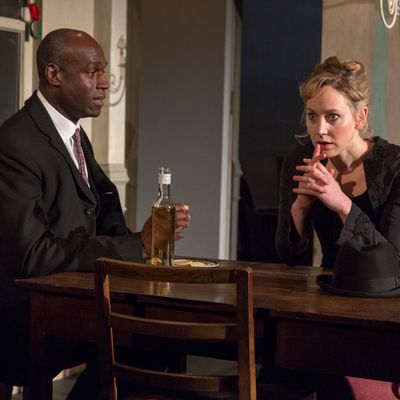
In 1982, I was a lowly intern on an ambitious Hal Prince musical called A Doll’s Life. With a book by (of all people) Betty Comden and Adolph Green, it was a very dark look at what might have happened to Ibsen’s Nora Helmer in the months after she infamously slammed the door on her husband and children in A Doll’s House — and what might have happened to womanhood in general in the hundred years since. This line of inquiry presupposed that the play could use updating: that its verities, shocking in 1879, were not quite eternal. I’m not sure that having Nora lead a strike in a herring cannery and then become a noted parfumier made her story more timely (or credible); in any case, despite glorious music by Larry Grossman, A Doll’s Life flopped big-time. Meanwhile, A Doll’s House keeps going, in many years still among the most produced plays in the world.
The terrific if not perfect Young Vic production now at BAM shows why. Neither the director, Carrie Cracknell, nor time itself has diminished the effectiveness of Ibsen’s brilliant architecture. The drama of Nora’s entrapment by a society that infantilizes women, by a marriage that enforces society’s norms, and by a crime she has committed to save that marriage, closes in on her and the audience inexorably, like a room whose walls are shrinking. Uncannily, the play makes her means of escape as inevitable as it is shocking. Cracknell emphasizes this by staging the story on a revolving cutaway model of the Helmers’ apartment, brilliantly designed (at a slightly less than adult scale) by Ian MacNeil. As the unmerry-go-round spins somewhat nauseatingly from parlor to dining room to Nora’s bedroom to husband Torvald’s study, the straight shot of the hallway to the front door keeps flickering into view.
Cracknell is also working with a very strong star in Hattie Morahan. Many actresses seem to collude in Nora’s diminishment by taking their cues from Torvald’s dehumanizing pet names for her; in Simon Stephens’s clean but sometimes meddlesome translation these include, among much other fauna, dove, bluebird, swallow, skylark, and chaffinch. (It’s a freaking aviary chez Helmer.) The fluttery birdbrain approach to Nora can be valid, but misses opportunities. Instead, Morahan makes her an active force in her own downfall, emphasizing qualities she obviously brought with her, like a miserable dowry, into the marriage. Her easy lying, petty gluttony, hollow flirting, and mania for money are so ingrained you may begin to wonder what could be attractive about such a creature.
But that’s the point: This is what 19th-century society desired and made of middle-class women. Treated as expensive playthings, they played back expensively. The production emphasizes the idea — perhaps harder than necessary — by moving the setting forward (to judge from the wax-cylinder phonograph and electric Christmas lights) about 25 years, to what looks like 1910, with universal suffrage in Norway just around the corner. In that context, Nora’s nearly complete ignorance of the world outside the home (crucially, she doesn’t know how loans work) seems more shameful and horrific, as does Torvald’s jovial paternalism. As played by the youthful Dominic Rowan with a kind of Kenlike insipidity, Torvald, it’s clear, is trapped in the doll’s house too.
These choices, smart and exciting though they are, have some unintended consequences. Reaching beneath the social skin of their characters, Monahan and Rowan court a kind of weirdness, with bug eyes and operetta puffery, that a modern audience may have difficulty reconciling with the crucial realism of Ibsen’s text. (Some of the supporting roles are overacted too.) We must feel that the constraints under which women (and men) have continued to struggle are bigger and of longer duration than any individual craziness. The argument can’t be ad hominem or ad feminam; A Doll’s House was, after all, one reason Norway achieved its universal suffrage before any other country. I’m not sure you ought to leave a production of it feeling that no one but the maids should be allowed to vote.
Basically it’s a matter of balance, and for actors who have been in the roles, off and on, for almost two years, that’s going to shift a bit each night. (As does the actual infant “playing” baby Emmy, who steals the show with his/her total commitment to naturalism.) In any case, by the time the play reaches its famous last scene, in which Nora announces her departure and Torvald tries to forestall it, the drama is as riveting as ever. Fighting incoherently for survival — a survival that demands irreconcilable outcomes — Nora and Torvald are no longer a woman and a man; they are stripped of every certainty that society had clothed them in for their own protection. In the nakedness of their narcissism and naturalism, they steal the show right back from that damn baby. And obviate the need for any further tuneful updates.
A Doll’s House is at BAM’s Harvey Theater through March 16.

